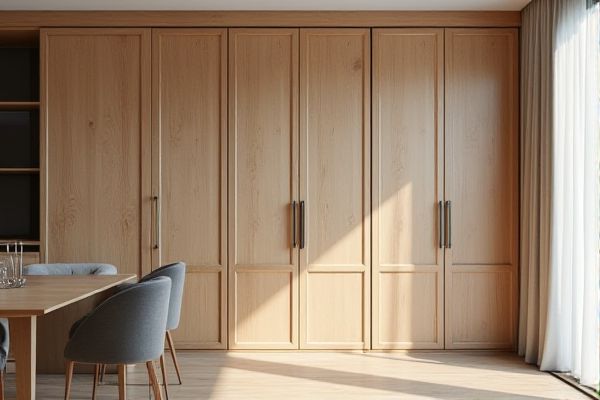
Tambour door cabinets save space by sliding open along a track, making them ideal for compact areas, while hinged door cabinets offer full access with doors that swing outward, suited for larger spaces. Explore the detailed comparison to determine which cabinet style best fits your storage needs and spatial constraints.
Table of Comparison
| Feature | Tambour Door Cabinet | Hinged Door Cabinet |
|---|---|---|
| Door Mechanism | Rolls or slides along vertical tracks | Swings open on hinges |
| Space Efficiency | Compact, no extra clearance needed | Requires clearance to swing open |
| Ease of Access | Quick access with door fully retracted | Full opening but limited by hinge side |
| Installation Complexity | More complex due to sliding mechanism | Simple and straightforward |
| Maintenance | Requires regular track cleaning and lubrication | Low maintenance, hinges may need occasional lubrication |
| Durability | Moderate; sliding parts can wear out | High; hinge mechanisms are robust |
| Aesthetic Appeal | Modern, sleek look | Traditional, classic appearance |
| Typical Use Cases | Office furniture, small spaces, modern interiors | Residential kitchens, storage rooms, general cabinetry |
| Cost | Generally higher due to mechanism | Usually lower and more affordable |
Introduction to Tambour Door and Hinged Door Cabinets
Tambour door cabinets feature flexible, slatted doors that slide vertically or horizontally, saving space and offering easy access in tight areas. Hinged door cabinets use traditional swinging doors attached with hinges, providing full frontal access and a classic design ideal for spacious layouts. Both cabinet types cater to different storage needs and spatial constraints, with tambour doors excelling in compact or office environments and hinged doors preferred in residential or larger workspace settings.
Design and Aesthetics Comparison
Tambour door cabinets feature sleek, space-saving slatted doors that retract vertically, offering a modern and minimalist design ideal for compact spaces. Hinged door cabinets provide a traditional aesthetic with fully opened doors that swing outward, allowing unobstructed access but requiring clear surrounding space. Your choice depends on balancing contemporary style and spatial efficiency with classic design and ease of access.
Space Efficiency and Footprint
Tambour door cabinets maximize space efficiency by utilizing sliding doors that retract vertically or horizontally, eliminating the need for clearance space required by hinged doors. This design reduces the cabinet's overall footprint, making it ideal for compact or high-traffic areas where space conservation is crucial. Hinged door cabinets require open door swing space, limiting their placement and potentially obstructing nearby pathways or workspaces.
Ease of Access and Usability
Tambour door cabinets provide seamless ease of access with their sliding doors that retract horizontally into the cabinet, eliminating the need for extra clearance space and allowing quick retrieval of stored items. Hinged door cabinets require full door swing space, potentially obstructing nearby areas and limiting accessibility in tight spaces. For usability, tambour doors offer continuous access without door obstruction, while hinged doors may provide a more traditional aesthetic but can hinder workflow in compact environments.
Durability and Maintenance
Tambour door cabinets feature slatted doors that roll up smoothly, reducing wear on hinges and hinges-related hardware, offering enhanced durability in high-traffic environments. Hinged door cabinets rely heavily on hinge mechanisms that may require periodic lubrication and adjustments to prevent sagging or misalignment, increasing maintenance needs over time. The tambour design minimizes dust accumulation and damage, making maintenance simpler and prolonging cabinet lifespan compared to traditional hinged doors.
Material and Construction Differences
Tambour door cabinets feature flexible slats made from materials like wood, PVC, or aluminum that slide along tracks, allowing the door to roll up or sideways for compact access. Hinged door cabinets are constructed with solid panels, typically wood or metal, attached to frames by metal hinges, providing full door swing clearance. Understanding these material and construction differences helps you select a cabinet that meets your space, durability, and design preferences.
Installation and Customization Options
Tambour door cabinets offer flexible installation with space-saving sliding doors that require less clearance, making them ideal for compact areas, while hinged door cabinets need more room to open fully but allow straightforward hardware installation. Customization of tambour door cabinets includes options for different slat materials, finishes, and track systems to fit unique design needs, whereas hinged door cabinets provide versatile choices in door styles, hinges, and surface treatments for personalized aesthetics. Your selection depends on spatial constraints and desired customization levels for ease of installation and tailored appearance.
Cost and Budget Considerations
Tambour door cabinets typically cost more upfront due to their complex rolling mechanism and space-saving design, making them ideal for maximizing storage in tight areas. Hinged door cabinets generally offer a more budget-friendly option, with simpler construction and easier maintenance reducing long-term expenses. Your choice should weigh initial investment against space efficiency and durability needs to ensure optimal budget allocation.
Ideal Use Cases and Applications
Tambour door cabinets excel in tight spaces where sliding doors offer easy access without requiring extra clearance, making them ideal for offices, workshops, and kitchens with limited room. Hinged door cabinets provide full visibility and wide access to contents, suiting traditional storage needs in residential kitchens, garages, and utility rooms. Your choice depends on space constraints and accessibility preferences, with tambour doors optimizing compact areas and hinged doors maximizing open access.
Conclusion: Choosing the Right Cabinet for Your Needs
Tambour door cabinets offer space-saving convenience with their sliding, roll-up doors ideal for compact areas, while hinged door cabinets provide full, unobstructed access and greater design versatility. Your choice depends on whether you prioritize efficient space management or ease of use and accessibility. Assess your specific storage needs and room layout to select the cabinet type that best enhances your organization and workflow.
 homyna.com
homyna.com